Tweets
Replying to @shahselbe
I got a backer question about that one and the answer is I don’t know! That’s one I haven’t taken apart — yet :)
(original)
Replying to @shahselbe
A1000 is a no go, as is the A168. The watches with the electroluminescent “Illuminator” backlight have a pretty different physical structure inside, and the board definitely doesn’t fit. Having said that, this is the stainless steel A158, and it fits that model perfectly!
(original)
Replying to @justAfanDavid
Crowd Supply will have the definitive answer on this, but I believe that as long as you update the shipping address in your profile before we start fulfilling orders, you should be all set. @crowd_supply does that sound right?
(original)
Replying to @DHammarskjold, @oshpark and @OSHStencils
Not as sure tho about trying to put the stencil in the board. When I ordered these light sensor boards with a cutout for the phototransistor, the laser didn’t cut fully through; I had to pop out the hole with tweezers. Might not be ideal for small cutouts. https://twitter.com/josecastillo/status/1460068761034182657
(original)
Replying to @DHammarskjold, @oshpark and @OSHStencils
They are — looks a bit tight. doesn’t it? I admit that I may be pulling an Icarus here — OSH Park’s flex service guidelines say 10 mil drill and 5 mil annular ring are the minimums — but hey, it worked this time! https://docs.oshpark.com/services/flex/
(original)
Replying to @josecastillo
ugh. Went on a quick three-mile jog before sunset, and the whole way I was visualizing the kinds of data I could be producing. But of course I wasn’t wearing this yet; the code isn’t done, it’s barely started.
Half-tempted to stay late at the shop tonight until it’s finished.(original)
Replying to @josecastillo
Promising: added FIFO support to our accelerometer driver, which means it can stash away 25 readings that we can read in a burst once a second. Eats up less power than waking up the whole gadget! Next step: log those readings to the Flash chip. This will become our training data.
(original)
Replying to @josecastillo
“There was something poignant about Facebook’s insistence that it was actually a place for people to find other people — because it was obviously by then a place where lonely retirees turn into blood-and-soil fascists, and because Facebook had long seemed so wildly indifferent.”
(original)
The perfect description of Facebook. In part: “A hugely profitable but widely detested derangement engine ruled by a sociopathic algorithm, reviled and abandoned and in every sense but the most literal a haunted space station overrun by goblins and skunks.”https://defector.com/facebook-meta-asks-wouldnt-it-be-nice-to-die/
(original)
Replying to @bwshockley, @sparkfun and @adafruit
Two: you could direct folks to @adafruit’s listing for a 9-pin JST-SH, which makes it a lot more accessible and foolproof. Folks could even design little boards with their own 9-pin SH connectors — pairing boards with no soldering required! https://www.adafruit.com/product/4350
(original)
Replying to @bwshockley, @sparkfun and @adafruit
I love this! One thought: if you’re going with JST-SH on the legs, consider adding a ninth pin (for GND) and using a 9-pin JST-SH? Two benefits: one, you’d only need one cable for simple things like a button, an LED or a low-power sensor (powered by a GPIO pin). (continued)
(original)
Replying to @SamTingersoll, @oshpark and @OSHStencils
This is just @oshpark’s flex service! Thin polyimide core with clear soldermask and an ENIG finish 😎
(original)
Replying to @josecastillo
in today’s backer update you’re going to see a photo of an early Flash board prototype that’s slightly scorched and drowned in flux. trust me when I say I can do better.
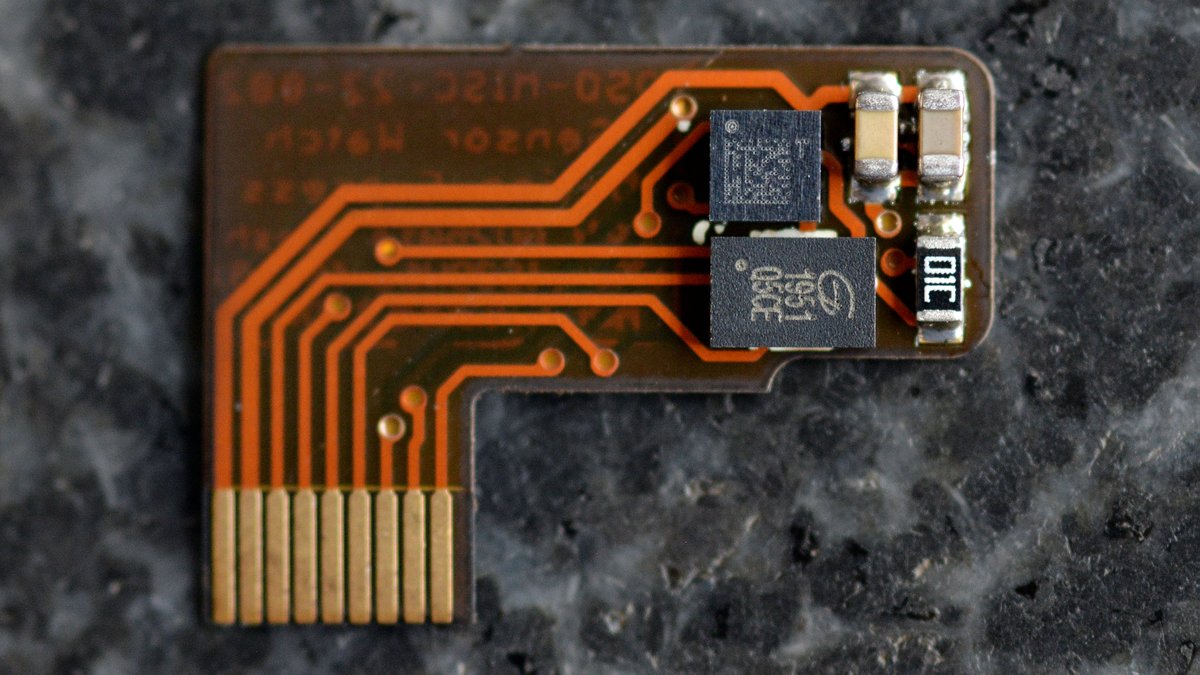
(original)
Yesterday was astronomy + writing the backer update. Today: back on machine learning! AT LAST I’ve had the Motion “Express” board fabbed. That’s an accelerometer and a Flash chip all on one board! also I HAVE A FLIPPIN STENCIL THIS TIME so maybe I won’t have to rework it 3 times.

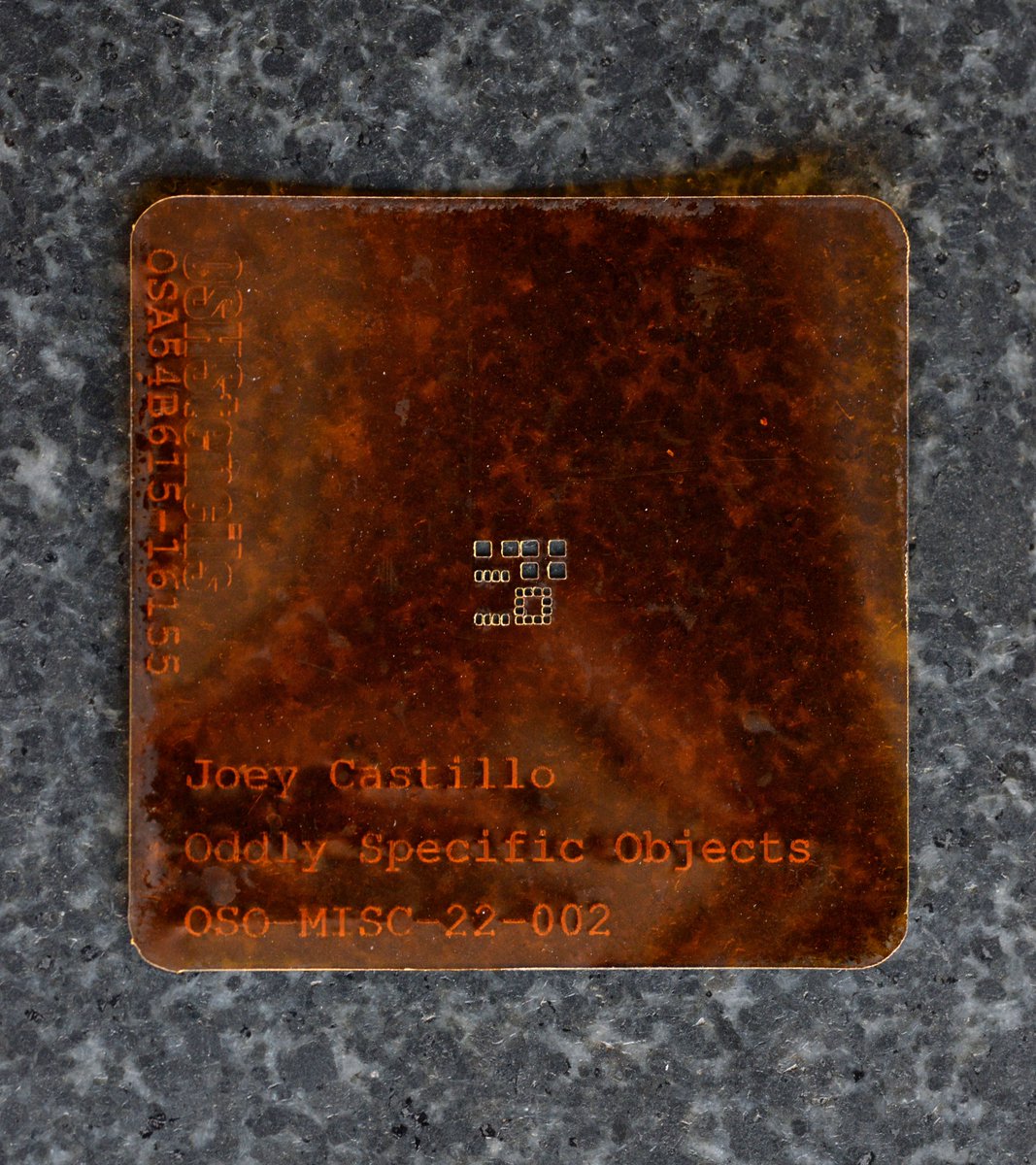
(original)
Replying to @josecastillo
Anyway: not quite done. Still doesn’t support fractional Julian dates, so you only get one data point per day; fine for RA/Dec, less so for altitude and azimuth. I also need to add low power updates for those last two so it can update sky position in sleep mode. still! excite! :D
(original)
Replying to @josecastillo
I can also speed up that math eventually; the watch runs at 4 MHz for low power reasons, but I can easily ramp up to 16 MHz during a calculation & ramp right back down afterwards. With a little more clock work I could even run the watch at 32 MHz, but this is good enough for now.
(original)
Replying to @josecastillo
This was also a good opportunity to use the blinking character API I built a few months ago. The math takes a while, especially for the outer planets, and it locks up the UI. The SAM L22’s LCD controller can blink that “C” for “Calculating” autonomously while the CPU is occupied.
(original)
FINALLY, I have the solar system on my wrist! Decided to split the Orrery in half; this is the new Astronomy complication, and it’s my new favorite! This watch face calculates altitude+azimuth for any planet in the solar system, plus right ascension, declination & distance in AU!
(original)
Replying to @bateskecom
this isn’t gatekeeping btw, or I don’t mean it to be; if javascript works for someone I say go for it! I’m just shocked at how much it undergirds so much of our lives: the web, banking, commerce, travel — space travel? It’s just wild that we use it and it manages to keep working.
(original)
Replying to @josecastillo
😑 Wordle 242 5/6*
🟨⬛⬛⬛⬛
⬛🟩🟨⬛⬛
⬛🟩⬛⬛🟨
🟨🟩🟩⬛⬛
🟩🟩🟩🟩🟩(original)
Replying to @josecastillo
actually this is doubly funny because I forgot to take Earth out of the planet menu. I needed it for coordinates for the orrery, although it’s less useful here. Still: we’re dutifully calculating a vector, as well as the distance from the Flushing stop to the center of the Earth.
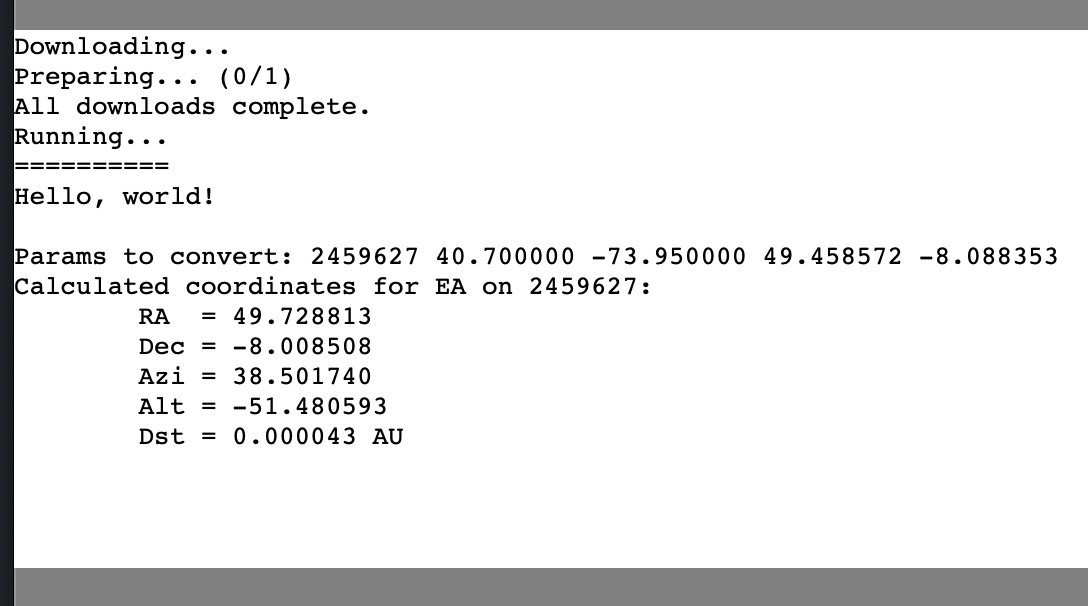
(original)
Replying to @bateskecom
For certain values of “works”, I suppose! James Mickens has a great piece on web tech that has a lovely section on Javascript; worth a read if you haven’t seen it. The whole thing captures my astonishment at the fact that Javascript somehow runs our world. https://scholar.harvard.edu/files/mickens/files/towashitallaway.pdf
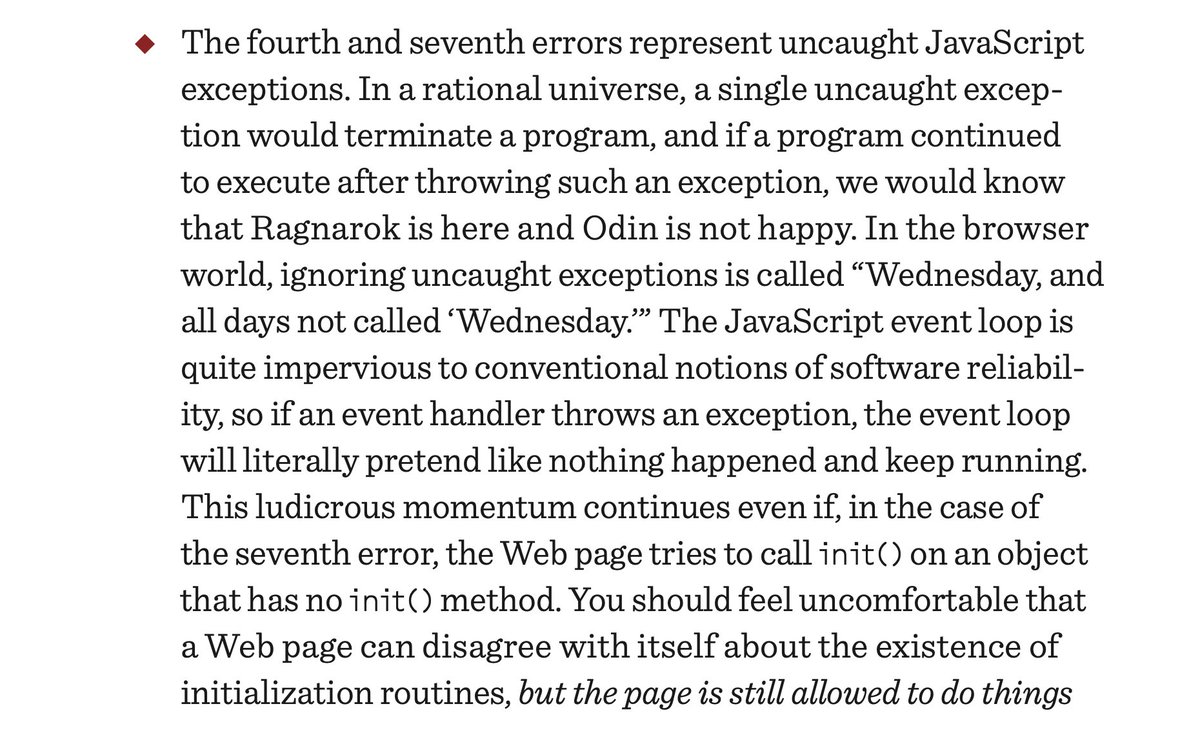
(original)
Replying to @bateskecom
It really is wild that of all the programming languages out there, this is the one that became the lingua franca of our globe-spanning civilizational triumph of a computer network.
(original)
Replying to @bateskecom
lol I just typed that into a console to see what would happen and now I’ve sworn off javascript again
(original)
Replying to @josecastillo
Oh, and it defaults to calculating sky coordinates for New York. Brooklyn, specifically, or more specifically Flushing Ave at the intersection with Union and Marcy. 40.70 N, 73.95 W
(original)
Replying to @josecastillo
Orrery V1 now calculates right ascension, declination, azimuth, altitude & distance to all planets + the moon! Moon seems a little less accurate, but then, it’s big; you’ll find it. Anyway. Tomorrow: UX for this whole thing. I’m super stoked for that part. https://joeycastillo.sdf.org/orrery-v1/watch.html
(original)
Replying to @josecastillo
And… there it is. All the data matches up (within reason, seeing as they’re using a supercomputer and I’ve truncated the terms to fit on a wristwatch).
The mistake, incidentally: all the math happens in radians, but I was passing in our latitude and longitude in degrees. oops!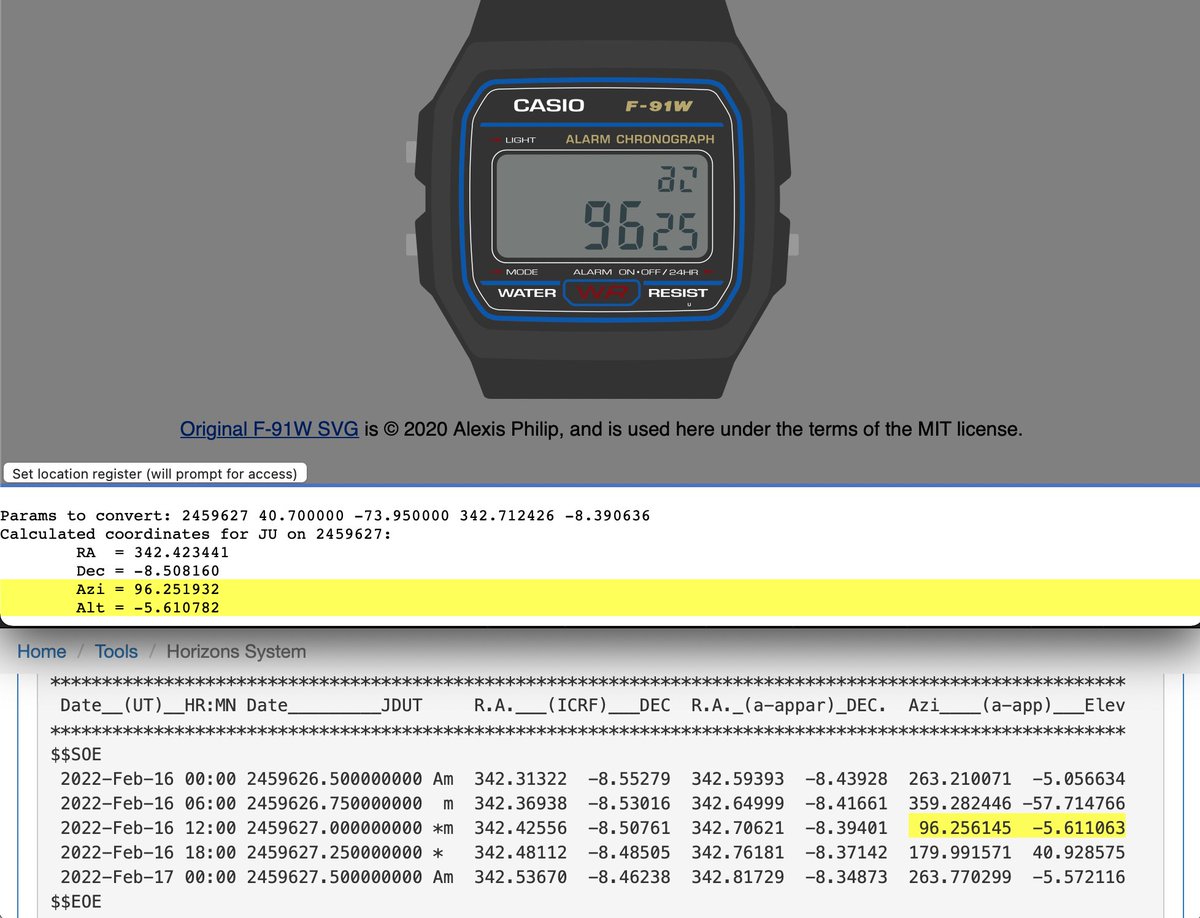
(original)
Replying to @josecastillo
and of course just as I lay down in bed — literally as my head hits my pillow — I realize where I’ve screwed up. I’m certain of it. so certain I’m calling it now and fetching my laptop
(original)
Replying to @josecastillo
this one felt gutsy, but I figured if nothing else I’d get another vowel out of the turn. Glad I went for it. Wordle 241 2/6*
🟩🟩⬛⬛⬛
🟩🟩🟩🟩🟩(original)
Replying to @josecastillo
Well, good news / bad news. Good news is our right ascension and declination math works. Bad news is the conversion to altitude and azimuth is borked. No matter; still a good amount of progress today. I think I can get this done tomorrow (and still write Thursday’s backer update)
(original)
Replying to @M_uh_lee, @NYC_DOT and @NYCMayor
oh my god I cannot stress enough: if you are on the fence about watching the video DO NOT WATCH THE VIDEO.
(original)
RT @ajbauer: A rat done bit my sister Nell…
(original)
Replying to @josecastillo
OK this is fun: we want to calculate the position of Jupiter, right? Well we have to do it twice: once to get the distance, which tells us how long its light will take to get here (49 minutes); then we do it again for where it was 49 minutes ago, because that’s where it’ll appear
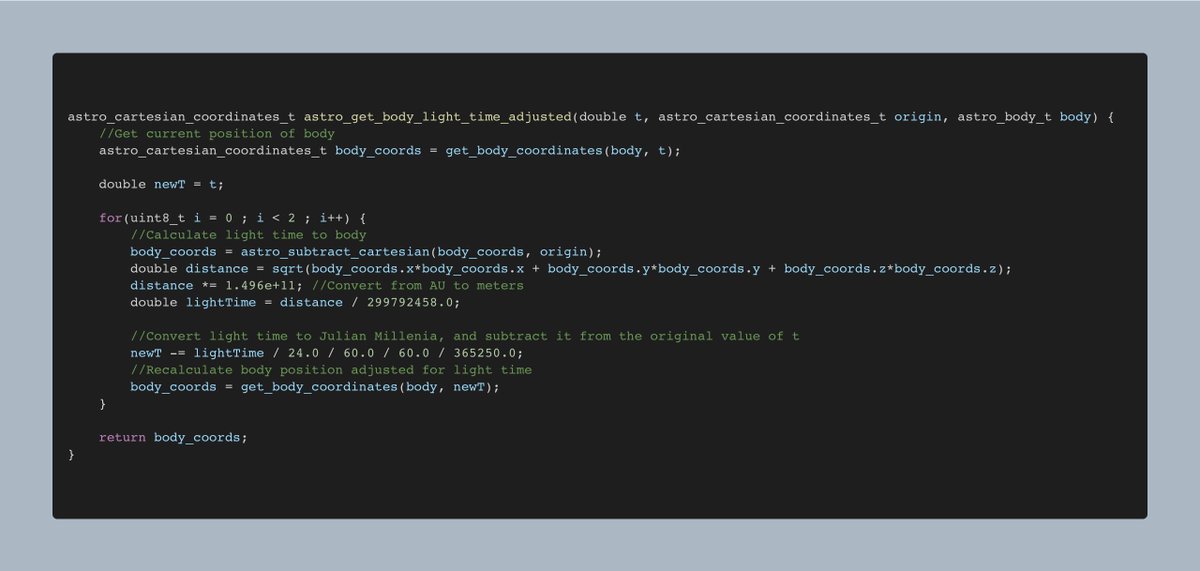
(original)
Replying to @josecastillo
I’m going to be honest, I don’t understand 100% of the math happening here, but from the bits I do grok, I sense it’s all pretty comprehensible. Like, at one point, we have to convert from a heliocentric to a geocentric frame. Complicated, right? Turns out it’s just subtraction.
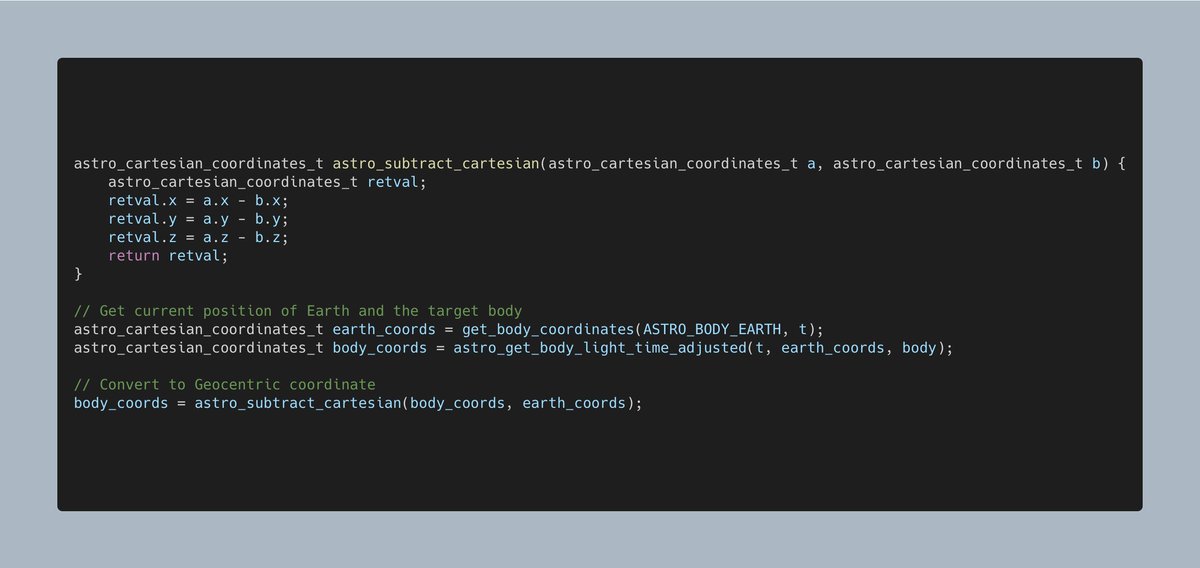
(original)
Replying to @moxnr
So there are different versions of the equations that yield answers in different coordinate systems, but the version I’m using (VSOP87a) yields coordinates that assume the sun is at the center (0,0,0), and (I think) has one of the horizontal axes aligned with Earth’s equinox.
(original)
Replying to @josecastillo
YEAH BABY, YEAH!!!
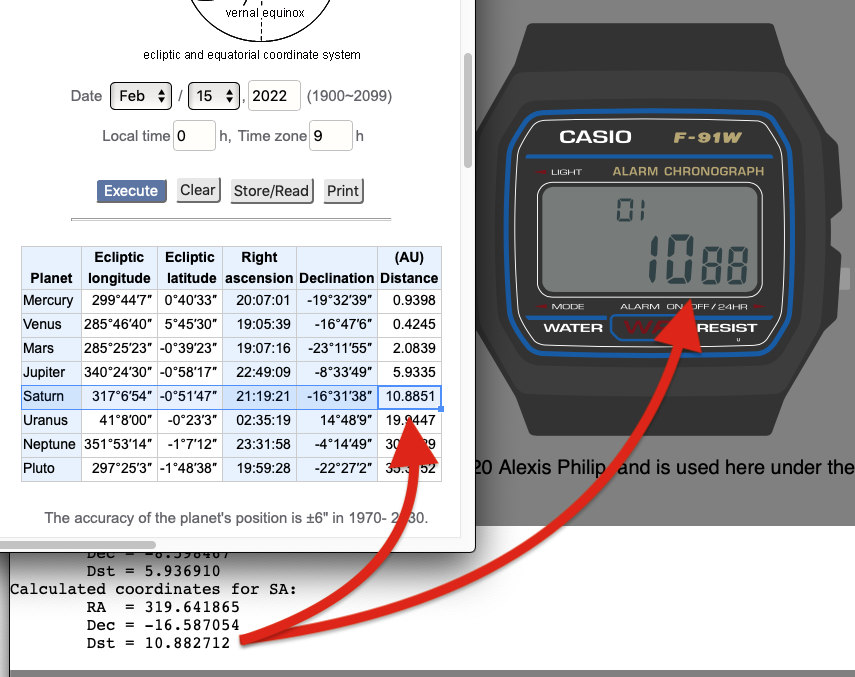
(original)
Replying to @josecastillo
ok I think I’m mostly there (need to implement some matrix multiplication still that doesn’t port over easily) but I have to say: wow. There is absolutely NO WAY I would have gotten here on my own. It’s all comprehensible, but there’s A LOT of domain-specific math happening here.
(original)
Replying to @MakeAugusta and @cabe_bedlam
I’m just too lazy to hunt for my schematics and too addled to be sure I’ll remember why I did things. Silkscreen documentation is a note-to-self in the one place I’m sure to find it.
(original)
Replying to @josecastillo
fundamentally the problem space is this: I have the positions of the planets in that first struct: X/Y/Z coordinates. I want to convert that to the second struct: coordinates in the sky as seen from Earth. It’s happening in this function. This is grokable. https://github.com/gmiller123456/astrogreg/blob/ff3415d46d2b2ffccb1a65c9b5883e84325a51fa/vsop87-multilang/astrolib.js#L10
(original)
ok I am not going to live tweet astronomy learnings today, BUT I’ve decided to start over from scratch (and to port what I need from that Javascript astrolib after all). I wanted to avoid this because I find Javascript’s lack of types maddening. anyway, step 1: define some types.
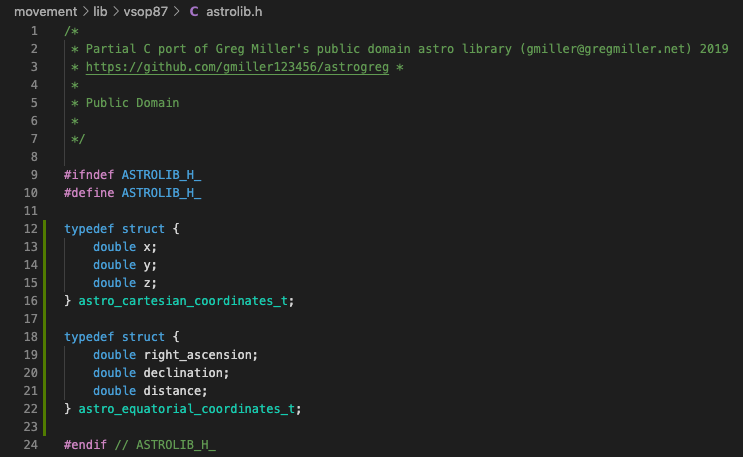
(original)
Replying to @ThomasCountz and @robin7331
alas this isn’t really answering your q of how I keep organized, because it feels like keeping organized is just me managing my mess of a brain and trying to take advantage of the stretches of time when it gets infatuated with an idea. I wish my process were more inspiring, haha.
(original)
Replying to @ThomasCountz and @robin7331
So like today, there was no todo item for “finish the orrery”, but last time I got an itch to do planetary stuff I embraced the period of focus / distraction and moved it as far forward as I could, and I tried to leave it in a state where future-Joey could pick up the ball again.
(original)
Replying to @ThomasCountz and @robin7331
I was going to say this is how the watch started when I was focused on Open Book stuff, but the watch distraction ended up consuming me for the better part of a year. Which is good, I learned a lot from it, and I’m gonna ship it! But again: it feels like I was along for the ride.
(original)
Replying to @ThomasCountz and @robin7331
It was probably two days of not doing watch stuff, but in the end the board’s designed, it’s sent off to fab, and now I can put it on a shelf without it bothering me. And I advanced the state of that distraction so when it does come back from the fab, it’s further down the field.
(original)
Replying to @ThomasCountz and @robin7331
Like for example, a few weeks ago there was that distraction of the tiny ring idea. It’s one of those things where a better organized person would’ve said, “put that on the shelf! You have a list of things to focus on.” But I just let myself run the distraction to its conclusion.
(original)
Replying to @ThomasCountz and @robin7331
I think the main thing is if I get an itch, I can go into periods of hyperfocus on a thing, and sometimes that’s useful while other times it’s a distraction. for me I think the main things are managing focus & distraction because it feels sometimes like getting buffeted by waves.
(original)
Replying to @ThomasCountz and @robin7331
I mean the unfortunate thing is I’m not terribly organized; I think I just make up for it on volume. My todo list is 1/2 in a Notes app and 1/2 in Reminders, but they’re mostly places to put wild ideas or boring things that I need to get to, either of which I could easily forget.
(original)
Replying to @josecastillo
I have some angles, I think they’re close to the correct value, but brain really hurty now. it’s just been a while since I’ve done any trigonometry, or maybe it’s just 12:45 in the morning. anyway. to be continued tomorrow!
(original)
Replying to @josecastillo
Orrery V1 now prints planets’ coordinates to the console when you calculate them! https://joeycastillo.sdf.org/orrery-v1/watch.html
And the radius is much closer to NASA’s prediction now that we have more precise coordinates. So we have our distance to Jupiter; now we just need the angles.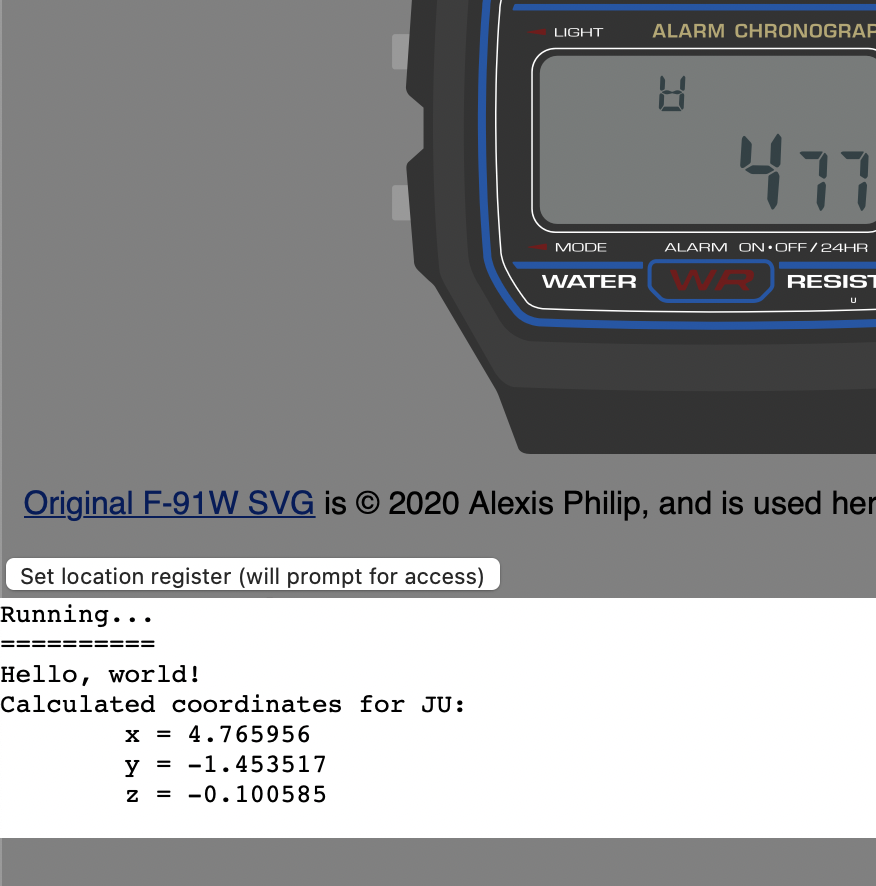
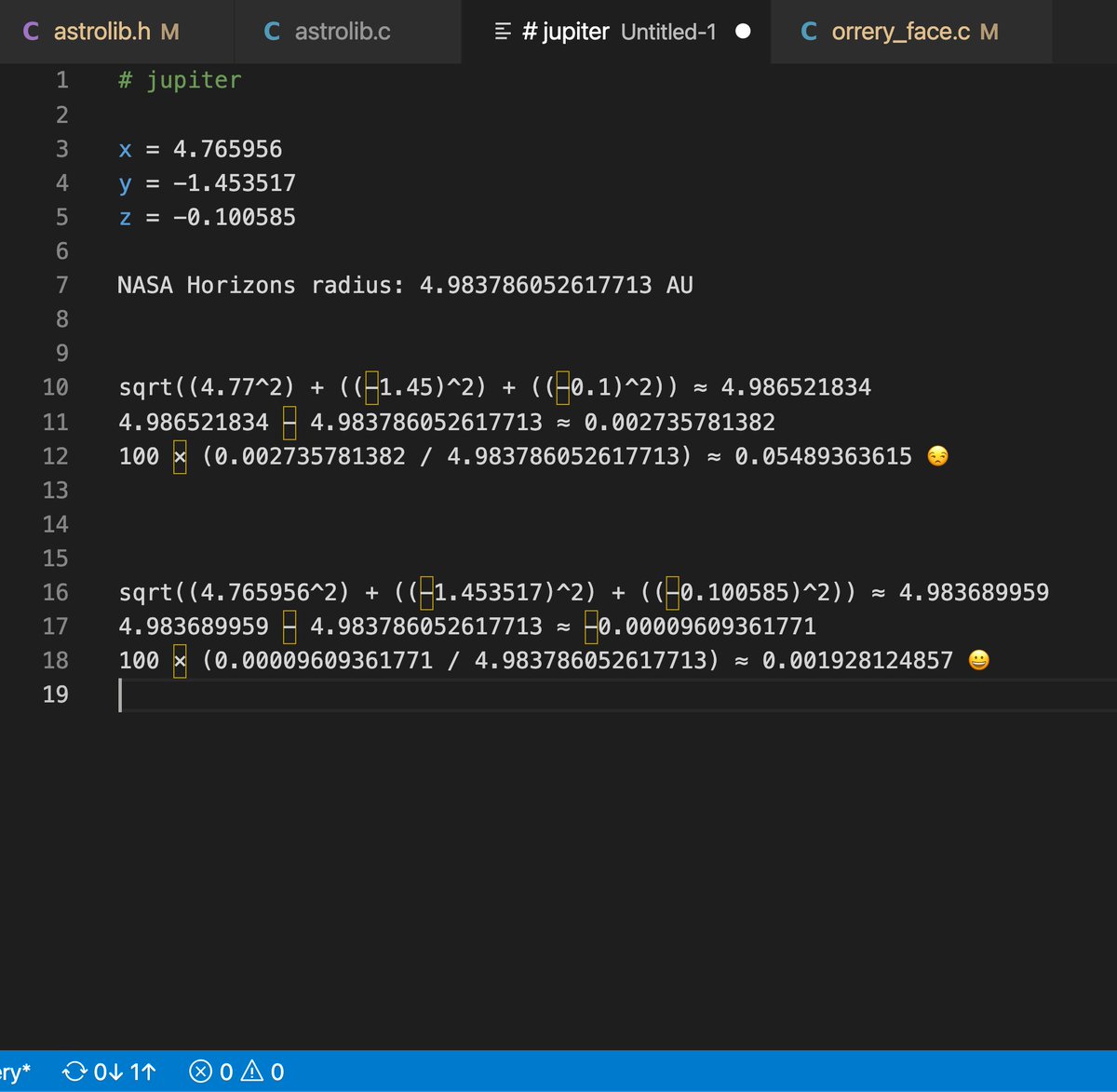
(original)
Replying to @josecastillo
Pausing for a late night grocery run, but I think I grok this part: we’re going to end up with a radius, an up/down angle and an all around angle, and that’s going to be this coordinate conversion. Once I have the precision this math should be easy.
(original)